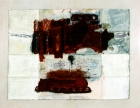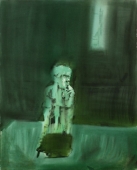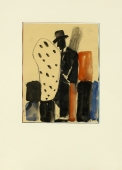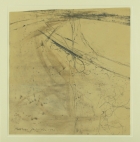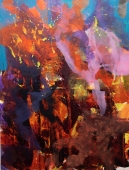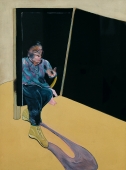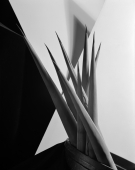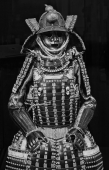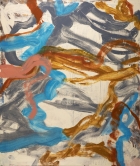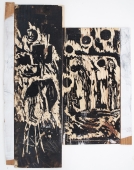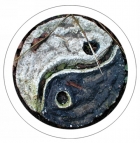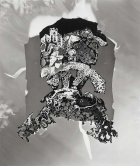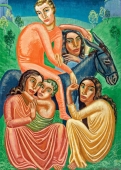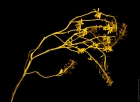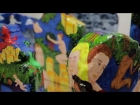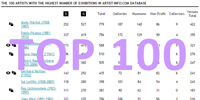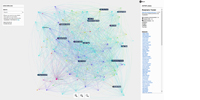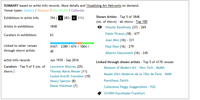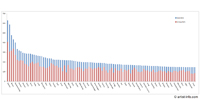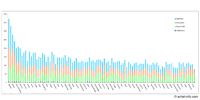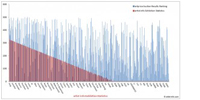Mat Collishaw - Standing Water
April 11 - July 8, 2018, Galerie Rudolfinum, Praha
To be a member of the Young British Artists, or YBAs, in the first half of the 1990s meant to belong in an art gang that has been largely instrumental in planting British art at the forefront of the global art scene. Mat Collishaw was one of the ‘gang leaders’. His first work – Bullet Hole – which has made his name, was first exhibited at Freeze in 1988, which his close friend Damien Hirst helped organize. The presented works were brutal, monumental; according to the critics, in the best case they referenced and echoed the motif of the doubting Thomas, and in the worst case they aroused sexplicit imaginations. The whole group of artists relished in art inspired by horror, shock, scandal – an approach which had its parallel, as well as foothold in tabloid press – dailies with lurid headlines. However, few people at the time noticed that their art had a deeper and more serious dimension. Over time, those who stuck it out grew more serious, their art more introspective; after twenty years, the deliberate controversy became ingrained in the art establishment – so less interesting, naturally. Paths diverged, every artist looked for their own theme.
Mat Collishaw’s (1966) exhibition in Prague, aptly named Standing Water, starts with an almost prophetic and yet programmatic photograph, the artist’s self-portrait Narcissus (1990). The young artist lies in the mud on a London street and, with a kind of ironic exaggeration, contemplates the reflection of his face in a dirty puddle. High and low, ephemerally gracious in all that dirty mud, hopeless timelessness of decay and a reference to an ancient myth. You could almost say that this set the course for Collishaw’s career as an artist, which nowadays amounts to a long journey.
With several exceptions, the works selected for the exhibition in Prague represent a cross section of the oeuvre of the artist, who will soon be 52, of the last ten years or so. The exhibition focuses on the contentual and formal relationship with the history of art. The way the themes are articulated can be best described with the metaphor of stepping over the threshold between the real world and a strange dream. Impulses from the past are selected with delicate sensitivity, unerring awareness of their specifically acute, borderline qualities. They converge in a point of conflict between beauty and horror, glaring light and infinite darkness; we feel it only takes a little and the works will turn into their exact opposite. The duality in Collishaw’s work – like the god Janus, the constant clash of two views, the past fertilizing the present, escalating the tension to a point of unpleasantness – all this serves the purpose of disquieting excitation that, in the audience, reliably necessitates a taking of position, contemplation of the path outlined by the artist and going deeper below the surface of things.
As narrator, Collishaw likes to use various stories from the past as his springboard; he does not discriminate between high and low, serious literature and pulp, paraphrasis of the finest art and the commonest tabloid stories. A textbook example of this is Last Meal on Death Row, a series of photographs of formally masterful still lifes mirroring Dutch art from the 17th century. They show, in fact, the last meal wishes of death row inmates in US prisons.
The author often uses ambivalent imagery of hidden violence which we only infer to be, like in a horror film, without seeing a drop of blood, like in the series Children of a Lesser God. Collishaw maintains that shock makes us feel alive, seduces with its own beauty and is, in a way, a serious approach. All great artists of the past, whom Collishaw takes on in his work, have used this approach. After all, dirty feet of the kneeling pilgrims in the forefront of Caravaggio’s Madonna of the Rosary 1607) caused an uproar in their time.
In a stark contrast to the somewhat distance play with technical curiosities of the early 20th century (All Things Fall, End of Innocence, Albion, etc.) stands Deliverance (2008), one of central works presented at the exhibition. The tragedy of the Beslan school siege, which took place at the beginning of September 2004, appears from the darkness in the form of staged fragments of dramatic rescue efforts. Scenes burst out like a flash, flicker for a while in incandescent light, fade into green and disappear without a trace, only to return after a while, with greater urgency, as a memento. The author succeeded in finding a technical way which replays a past tragedy in the present and brings the past event into the now without losing the situational context and its emotional charge.
To reflect on old art does not necessarily mean going back to the roots. Mat Collishaw has a singular ability to tap into the unique aura of old art which works in the new, present-day context. His attention is focuses mainly on the potential of reinterpretation, staging of a visual sensation where only the reverberations of original meanings are preserved. From the open series Black Mirror, from which two counterpart Caravaggio paintings in an opulent Murano glass frame will be seen at the Rudolfinum, the National Gallery curator Otto M. Urban chose a paraphrasis of Georges de la Tour’s painting A Different Self as an intervention in the Baroque art collections of the National Gallery in the Sternberg Palace. Retrospective confrontation with original paintings by Tintoretto, Ribera, Rubens, van Dyck and others raises loaded and inspiring questions which lead to discovery of unexpected relationships and contexts.
The exhibition Mat Collishaw. Standing Water is a project that organically fits into Galerie Rudolfinum’s idea of one major and continuously developed programming line: deep and inspiring relationships between modern art and the past, the history of art. British artists who recently exhibited at the Rudolfinum and fall into this bracket include the Chapman Brothers, Ged Quinn, Raqib Shaw, Glenn Brown and others.
The exhibition will be accompanied by a catalogue with a keynote essay of the exhibition curator Petr Nedoma and an interview of Otto M. Urban, curator at the National Gallery, with the artist, reproductions of all exhibited works and documentary images from the installation, which is the reason why the catalogue will not be out before the beginning of May.
In May, Artpark will be redesigned to pay homage to the work of Mat Collishaw, offering, among other attractions, a behind-the-scenes look at animation techniques and new media which the artist uses in his work. It is a great way to present, in an interactive way, Mat Collishaw’s work also to the youngest audiences. Artpark will remain a place for creative relaxation. As always, the exhibition will have an extensive associated programme for schools and the general public, including regular children’s workshops.
Admission to the exhibition Mat Collishaw. Standing Water is free of charge courtesy of the Avast Foundation.
Curator: Petr Nedoma
artist-info.com Exhibition Page
https://www.artist-info.com/exhibition/Galerie-Rudolfinum-Id380261

 Exhibition Announcements
Exhibition Announcements 












